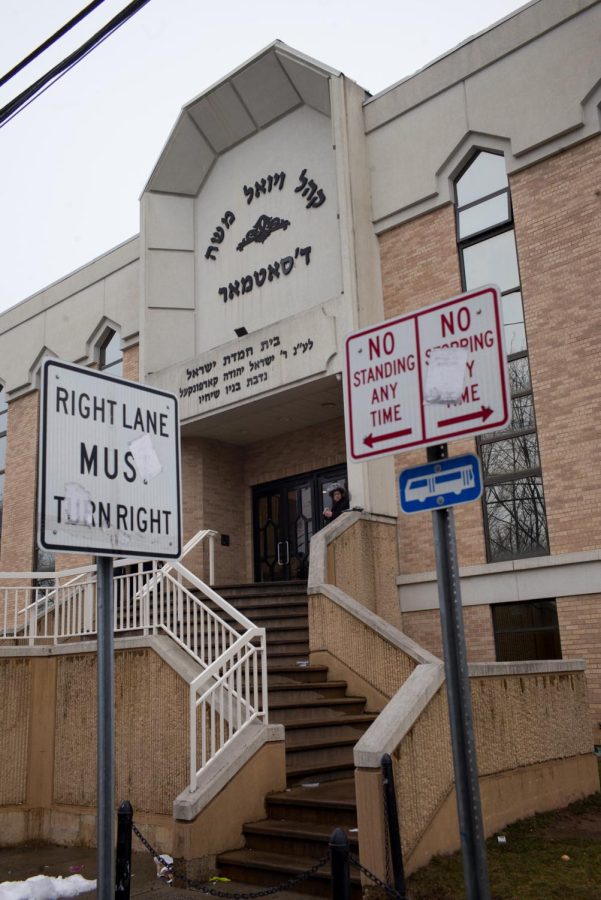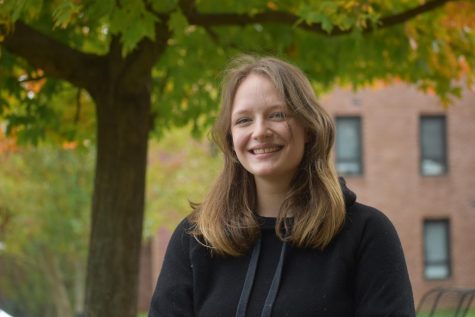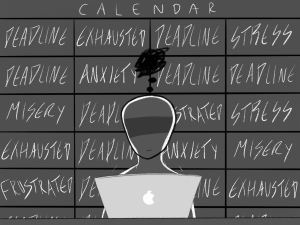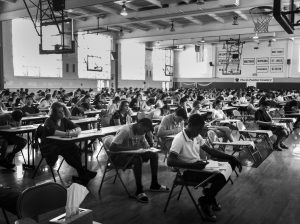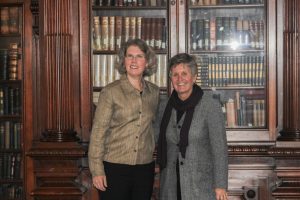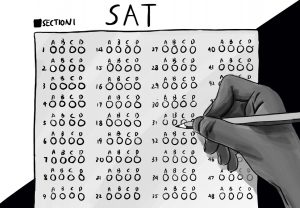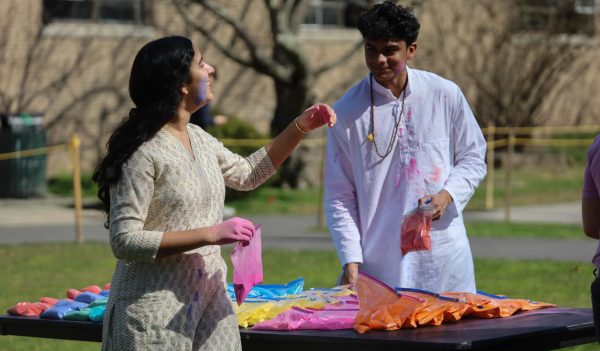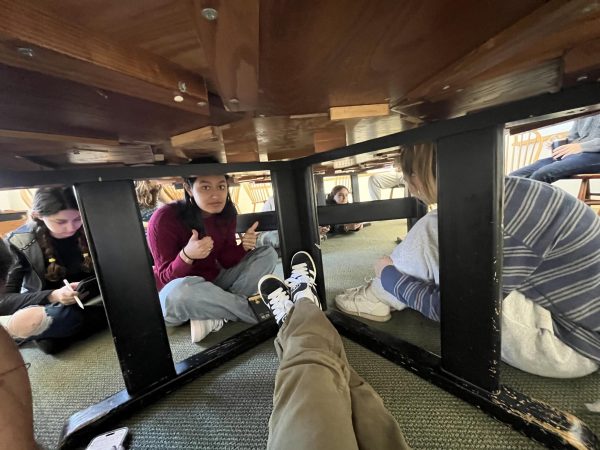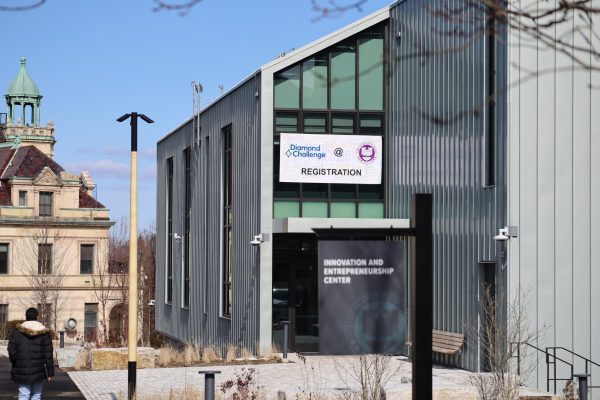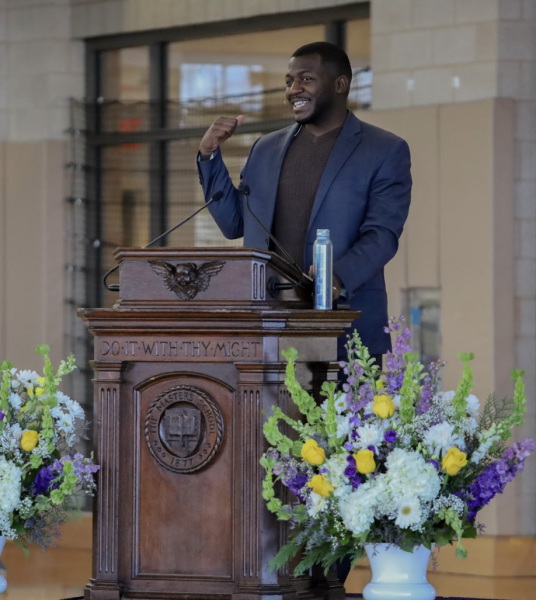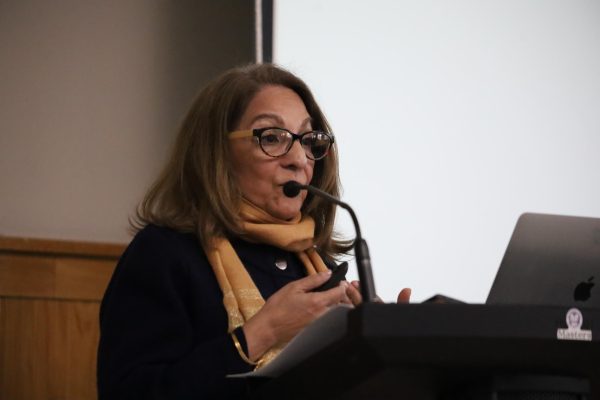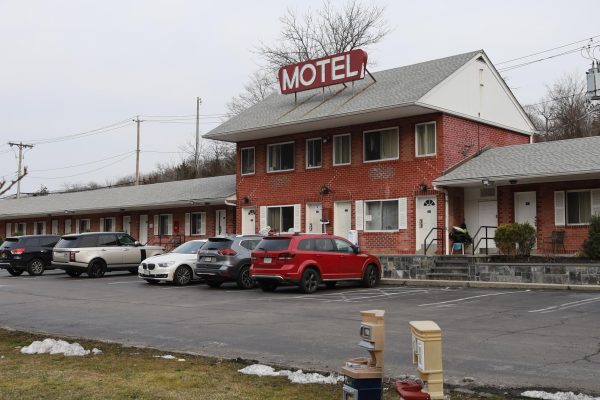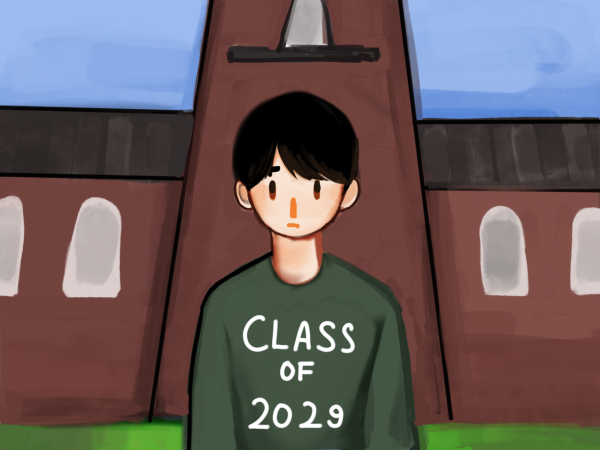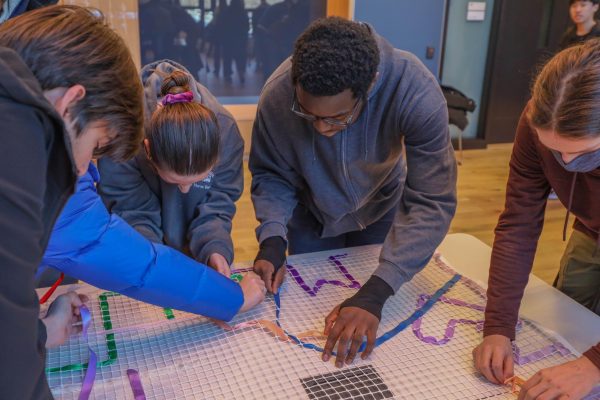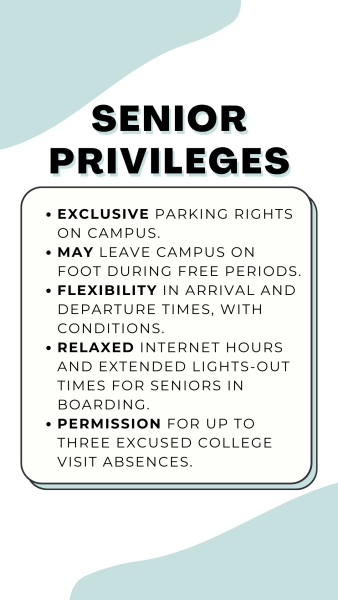Regulations aimed at supporting yeshiva students receive mixed reactions
A yeshiva in Ramapo, New York. In recent years, organizations like YAFFED have been advocating for educational equality in yeshivas, or private schools for the Orthodox Jewish community.
May 27, 2022
Naftuli Moster, executive director of Young Advocates for Fair Education (YAFFED), spoke to the community in a school-wide Morning Meeting on Thursday, March 10 about substantial equivalency and new guidelines being passed by the New York State Education Department. Substantial equivalency refers to a law that was first passed in 1894, mandating that nonpublic schools had to provide an education that was similar in quality and scope to that of public schools.
In recent years, a number of Hasidic private schools called yeshivas have been accused of providing substandard education to their students. YAFFED supports efforts to ensure that New York yeshivas comply with substantial equivalency rules. These yeshivas have pushed back against attempts to regulate them. The New York State Association of Independent Schools (NYSAIS), to which Masters belongs, also lobbied against initial New York State Education Department (NYSED) proposed rules on substantial equivalency because they would have required independent schools like Masters to be overseen by local school districts. In light of revisions to the proposed rules announced after Moster’s visit to school, NYSAIS now supports the plan.
Moster was introduced by senior Clyde Lederman, who has engaged with past Hasidic issues in Rockland County. As part of Masters Interested in Sharing and Helping (MISH) scheduling, students were invited to donate to YAFFED. That afternoon, following the speech, which called upon independent schools to advocate for substantial equivalency, Lederman was called into three separate meetings with various administrators. These meetings discussed Moster’s speech and the School’s stance on substantial equivalency, allegedly criticizing Lederman for invited Moster to speak. MISH was also asked to remove the ability for students to donate to YAFFED, according to Lederman and MISH co-chair Natalia Shane. Posters containing QR codes to donate to YAFFED through MISH were also removed from around the School, according to Mia Romanoff, who co-wrote an open letter along with Lederman regarding the issue.
Substantial Equivalency and Education Law § 3204.2
The first draft of Educational Law 3204, the regulation proposing new pathways to demonstrating substantial equivalency, was released in May 2019 after urging from groups like YAFFED. The 2019 proposal would have required the Dobbs Ferry school district to oversee the Masters curriculum, which is why Masters and NYSAIS opposed these regulations.
While the 2019 rules required local public school districts to monitor and determine whether non-public schools in their jurisdiction achieved substantial equivalency, the newest draft of regulations, released in March, allow independent schools like Masters to be accredited by associations such as NYSAIS to demonstrate their adequacy to the state. This year, Masters is undergoing the year-long accreditation process required every ten years by NYSAIS. Multiple facets of the School’s governance, curriculum and finances are examined to determine if Masters, and other independent member schools, is up to current educational standards.
“I think the new draft of the regulations released by [NYSED] reflect major accommodations made to NYSAIS which allow for our current reaccreditation to count as a pathway that determines substantial equivalency. With previous drafts, that certification, while not particularly onerous, was opposed [by NYSAIS] and would have been done by local public school districts,” Lederman said.
According to Romanoff, after the latest draft which counts accreditation through NYSAIS to demonstrate substantial equivalency, NYSAIS sent out an email stating they were no longer opposed to these regulations.
Educational Inequity in Yeshivas
Moster attended Hasidic yeshivas his entire life, specifically belonging to the Belz sect of the Hasidic community. Like many boys currently in Hasidic yeshivas, he received little to no secular education in school. Between the ages of seven to 12, he received 90 minutes of secular study a day, after ten hours of Judaic studies. When he entered high school, he received no secular study at all.
“As a young adult, I had this draw to pursue psychology as a degree and as a career. So I walked into a local college which caters to ultra-Orthodox Jews, but not necessarily Hasidic Jews… I quickly learned that I didn’t get even the education that would afford me a high school diploma or a GED. They wanted to give me an entrance exam, which consisted of writing an essay and doing an easy math quiz. I hadn’t heard the word essay before, let alone written one,” he said.
According to YAFFED, in a survey done of 127 ultra-Orthodox schools, 19.5% of students scored proficient in math and 19.7% proficient in ELA, compared to roughly 47% and 45% of students in New York public schools, respectively. In math, 66 yeshivas had at least one grade where 0% of students scored proficient; in ELA, 53 schools had at least one grade where 0% of students scored proficient.
Senior Matthew Williams, who has been invested in the issue since 2021 when he attended a committee inviting public comment on the original regulations, explained the level of inequity experienced at some yeshivas.
“We often only associate private schools with the very high quality, college acceptance extreme. In reality, there is this whole other group of private schools, a whole other group of people our age living nearby, that are on the opposite end – where people go to private schools that, in the opinion of myself and many others, are worse at preparing those students for the world than their local public school,” he said.
In his senior year of college, Moster began researching laws that pertained to nonpublic schools to better understand how and why his education, and other yeshiva students’ educations, were so limited.
In yeshivas, specifically Hasidic ones, which are some of the most limiting within the ultra-Orthodox umbrella, boys are educated and prepared to become rabbis. This is why they receive a nearly entirely religious education. Girls, on the other hand, often leave school better prepared than their male counterparts. They are expected to financially support the family, and are often not allowed to study the Judaic texts taught in boys’ yeshivas.
Moster emphasized that of the roughly 160,000 students in yeshivas in New York, not all attend Hasidic yeshivas. YAFFED estimates that, if non-Hasidic and girls’ yeshivas (which generally provide more secular studies) are eliminated from that number, there are a remaining 65,000 students who are receiving no basic, secular education in yeshivas.
A school like Ramaz in Manhattan, which is a Modern Orthodox day school, prides itself on providing “the gold standard in Judaic and general studies education” according to its website. Sascha Harris attended Ramaz from preschool through eighth grade.
“It was pretty intense. Half of my classes were Biblical studies or relating to Judaism and the other half were secular,” she said.
Harris now attends Columbia Prep, a college preparatory school, and she believes she was well-prepared for high school.
“I learned how to go between two different languages, because the Biblical studies are done in Hebrew. I learned a lot of analysis skills and how to analyze texts in my Talmud class,” she said. “I think certain schools prioritize the Jewish subjects over the secular subjects more than others, so I think it depends on the school. But from my experience, I feel like it was pretty equal.”
“I think I understand where [these regulations] are coming from to make sure that you get a holistic education that prepares you,” she said. “I believe they [yeshiva administrators] think the government is trying to control their curriculum. And they want freedom of expression and religion,” Harris said.
Moster said, “The fact that there are some yeshivas, in fact some ultra Orthodox yeshivas, that provide a decent balance of Judaic studies and secular studies proves that it’s possible.”
Lederman said, “If I were a leader of a modern Orthodox yeshiva or conservative yeshiva, I would not be concerned about these regulations, because they would know they’d be fine, just like us [Masters].”
In 2017, YAFFED began lobbying for more government intervention in the education and yeshiva schools.
“It only became an issue in recent years when we brought attention to the fact that there’s a small but growing number of nonpublic schools that actually don’t provide an education that is remotely substantially equivalent,” Moster said.
The intent of the regulations was to mandate that certain subjects be taught by qualified teachers for an adequate number of hours. Moster emphasized that these regulations do not specifically intervene in nonpublic schools’ curricula.
“The state doesn’t technically dictate curriculum. Even if these new regulations were to pass, it doesn’t prescribe what the curriculum should look like. It only outlines what are some subjects that must be taught,” he said. “I don’t know how much the state should get to dictate curriculum, but I’m saying at the moment, the state doesn’t.”
Lederman believes this subject is of critical importance to students at independent schools like Masters.
“As private school students we have an obligation, both as citizens but also as people in privileged positions, to ensure that all students are guaranteed an education. And we are in a position [of privilege] as a member School in NYSAIS – which has unfortunately in the past played a part in obstructing access to education for other private school students,” Lederman said.
Moster reiterated what Lederman said: “I think it is incumbent on everyone, when you see a justice of this scale and magnitude, to do something about it.
NYSAIS Response to Regulations
In 2019, NYSAIS, along with several independent schools in New York, successfully sued NYSED over the proposed substantial equivalency regulations. According to Mark Lauria, executive director of NYSAIS, it was not only NYSAIS that opposed the initial draft. He said, “It should be noted that the original regulations proposed in 2019 were opposed by the New York State School Boards Association as well as the New York Council of (Public) School Superintendents as well as NYSAIS and other organizations representing nonpublic schools.”
NYSAIS took most issue with local school districts monitoring private schools in their regions because it would limit private schools’ level of autonomy and privacy in defining what they teach.
Lauria said, “Whenever there is a question about the legal compliance of nonpublic schools, the ultimate adjudication should be made by the Board of Regents working through the New York State Education Department and not by local public school Boards of Education (LEA). As the LEAs have an inherent conflict of interest and often compete for students with the nonpublic schools in their districts, it is neither reasonable nor practical for this critical function to be relegated to them.”
Lederman believed that local district control did not pose as great a threat to nonpublic schools as many might think; he said, “The only role the local authority would play is once every five years, some of the superintendent staff would conduct some sort of preliminary examination of curriculum and teacher qualifications. The only role of the local authority was to flag an issue for Albany, which would have really conducted the follow-up. I think a lot of the misconception was that the local authority would have some sort of supervisory authority over the nonpublic schools within their borders, which is not the case at all.”
Lauria noted that the association is not opposed to the principles behind substantial equivalency, saying “NYSAIS supports the Board of Regents in their ongoing efforts to create a statewide educational environment conducive to the development of world-class educational programs. The improvements NYSAIS recommends to the draft regulations promote equity for all New York nonpublic school students to access a fair and equal education… NYSAIS supports regulations that effectively serve all students throughout the state while respecting the legally-established governance authority and curricular integrity of independent and religious schools.”
Laura Danforth echoed Lauria’s perspectives, saying “I concur with Lauria and NYSAIS’ positions on the most recent draft of the NYSED regulations in promoting equity for all New York nonpublic schools students’ access to a fair and equal education.”
Williams challenged NYSAIS’ perspective on substantial equivalency regulations. “I think NYSAIS thrives on not having people being very well informed on the issue. A lot of their talking points are sort of misguided… The line of NYSAIS is ‘We operate best independently.’ If you read NYSAIS communications, yeshivas are never talked about because it’s a losing argument,” he said.
Lederman reiterated Williams’ point, saying “Unless the NYSAIS leaders don’t work in education in New York, it would be very surprising to me to think that any of them would be unaware of what’s going on. Instead, I think they’re intent on preserving their coalition ties with, among other groups, the Hasidic yeshivas. As a result, they were willing to fight [these regulations] in a way that they might otherwise not have.”
Moster and Lederman both emphasized NYSAIS’ relationship with Orthodox groups may play a role in their position.
According to Moster, NYSAIS partners with other nonpublic school lobbying groups, including the ultra-Orthodox. Moster noted that because many Hasidic communities have a lot of financial need, due to the degree of poverty among their population (partially a result of their poor education), they receive government assistance. He added that, due to their partnerships with Hasidic lobbyists, NYSAIS and its member schools receive government funding.
“Believe it or not, your school probably gets government funding. A lot of it was helped by the yeshiva leaders of the yeshiva lobbyists,” he said.
Lederman added, “I think NYSAIS has historically benefited from a relationship with Hasidic yeshivas, and in turn Hasidic political leaders who command enormous influence in Albany. Over the past few decades, this has meant an incredible amount of money flowing into private schools via state grants – things such as attendance grants and vaccination grants. It has meant a general climate of deregulation when it comes to private schools.”
Moster additionally noted there was an economic incentive for NYSAIS to resist the first draft of regulations, and support the accredited schools pathway.
“If [NYSAIS] tell the state [they’re] only going to support it if they carve out a pathway for accredited schools, they’re essentially increasing their business, because now any school that is not accredited will come running to NYSAIS… that actually has financial implications for NYSAIS.”
Moster also acknowledged the desire for NYSAIS to preserve its independence, saying “Look, no business wants to be regulated.” However, he added that “It is our belief that neither version of the regulations would pose a significant burden on schools like The Masters School. It’s more so true in these rounds of the regulations, because the state explicitly included a carveout for accredited schools.”
He continued, “What’s problematic is they do this knowing full well what the consequences are for the kids that are not getting an education. It’s already a huge population, and it’s only growing by leaps and bounds. Fighting against these efforts in this selfish manner has real life implications for tens of thousands of kids.”
Moster urged young people to support the new rules. He said, “Anyone can speak out and submit public comment to tell the state that one way or another, they need to enforce the law, even if it is opposed by NYSAIS, even if it is opposed by your school leadership. It is the right thing to do to ensure that all children have the same kind of opportunities as you and your peers.”
Masters’ Response to YAFFED
After the halting of MISH funding to YAFFED, Romanoff and Lederman co-wrote an open letter to the administration the next day calling for an open dialogue on the issue. The final draft of this letter was released just before spring break began, circulating on social media and gaining many student signatures.
The letter criticizes the School’s actions in resisting substantial equivalency regulations, saying, “We learned of the struggle of over 150,000 students in New York, while our administration tried to persuade the state government that those children were less important than a minor regulatory inconvenience. From a position of immense privilege, they decided that avoiding an insignificant burden supersedes any social responsibility to help marginalized people, those who have no voice and no recourse.”
The letter noted that when the very first draft of regulations were discussed, the School contacted parents advocating that they submit public comments in opposition.
According to the letter, “It is because we have enjoyed the privilege of a Masters education that we can write this letter. We are not only referring to the critical thinking skills nor political awareness that make us informed members of our communities, but rather the ability to write these words at all. We are referring to the act of writing in the English language, something that is denied to more than 150,000 students today.”
The letter also expressed grievances at the School’s “approach to discourse and debate”, claiming Lederman was pulled into three meetings with administrators; in these meetings he was allegedly asked to publicly recant his support of substantial equivalency and express the School’s formal opinion.
“It was in these meetings that he was told that Moster never would have been allowed to come if the administration had been more vigilant censors,” the letter reads.
Before coming to Masters, YAFFED had been on the MISH calendar to visit the School since October, according to both Lederman and MISH co-chair Natalia Shane.
“The administration knew they were coming, and they’d been updated many, many times before they came,” Shane said.
“Both Masters and YAFFED are 501c3s, meaning they are non-taxable, not-for-profits that are not allowed to engage in political lobbying. One of the arguments that was originally made against Masters donating to YAFFED is that tax-wise, it would have been too political,” Shane said.
Shane noted that 501c3s may not donate to 501c4s, which are permitted by the Internal Revenue Service (IRS) to engage in political activities, if that money is used towards lobbying.
She said, “It is totally fine for a 501c3 to donate to another 501c3… YAFFED is fully allowed to be non-taxable and they are not political in a way that a 501c4 would be.”
During spring break, there was no communication between administration and the students involved. However, the Thursday after returning to school, on March 31, a coalition of students sent an open letter to the administration requesting a public forum or meeting. They also held an informational session in the Library Conference Room during lunch. A meeting was scheduled for April 5; several administrators and multiple students were present, including Williams.
“We sort of expected the meeting to be about policy. But from the outset… it was really a lot of – from my point of view – reprimanding without any clear delineation of what we did wrong. It felt like being guilted by my family, a little bit,” he said. “There was this air to the meeting that this was personally offensive and personally inappropriate and personally hurtful, whereas [we] see this as more of a student advocacy issue.”
The meeting ran for about 100 minutes. Williams said, “I think there was sort of a happy conclusion that was reached at the end, where we said ‘This is an advocacy issue and it’s not meant to be hurtful, however, this is something that we’re passionate about.’.”
“I think really that this issue is a compassion issue and about holding our administrators accountable,” he said.
Correction: An original draft of this article stated that the first draft of NYSED regulations was released in 2017. In fact, the first draft was released in May of 2019.




